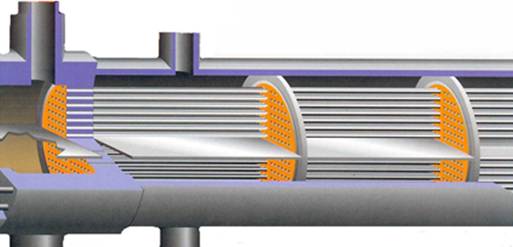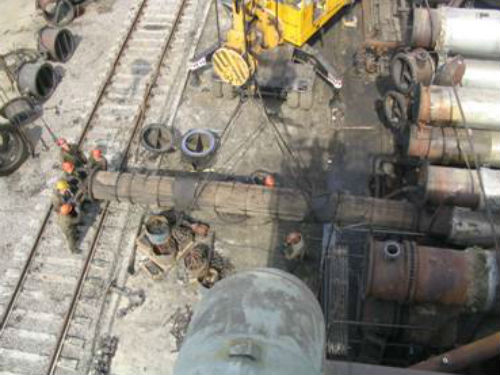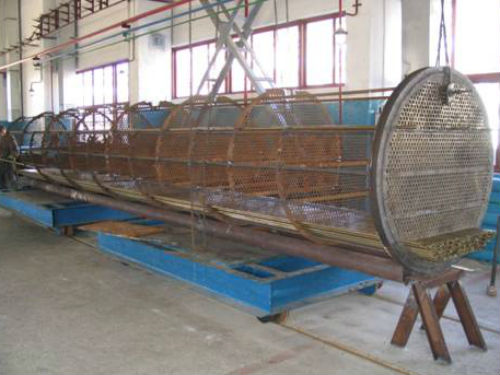Short information and contents
Use of heat-exchangers is integral part of any engineering process.
Heat-exchangers have got wide application.
Determining technical conditions of tube metal in bundles is very important task.
Defect detection in each tube is security of no-failure work of industry complex on the whole.
Main purpose is determination of condition of each tube. Traditional ways (hydraulic tests) do not give complete information.
Periodical inspection of equipment allows giving some recommendations for repairs and predicting durability.
We offer services for inspection of heat-exchangers with use of Eddy Current Testing. Extremely sensitive equipment allows discovering defects quickly and surely. Method is safe, reliable and acceptable for production with strong restraint and requirement according to technical conditions.
Importance of diagnostics of heat-exchange equipment
Importance of intratubal diagnostics consists of:
- On time diagnostics allows avoiding accidents, ecological damage, fines
- Diagnostics gives grounds for carrying out repairs
- Application of eddy current testing for evaluation of technical condition of metal of heat exchanging tubes allows saving time and money for enterprises – enterprise may not make a replacement of bundles, but replace only tubes with inadmissible defects according to results of eddy current testing before they break, not reducing operating efficiency of equipment
- After repairs activity of heat-exchange equipment is provided with most possible efficiency according to the results of testing
- Periodical testing provides monitoring of developing discovered defects, and as a result, deterioration level of heat-exchange equipment.
How to solve the problem
We are ready to offer a solution for determining the condition of pipelines in heat-exchangers:
- Exhaust-heat boilers
- Economizers
- Rrefrigerators
- High and low pressure heat exchangers
- High and low pressure condensers
- Scrubbers
Solution and services
Solution includes:
- Preparing for Carrying out data acquire (determination of parameters for testing and tube preparation)
- Carrying out data acquire
- Data analysis
- Registration of testing results
- Evaluation of completed works quality
Works are carried out by skilled staff with use of reliable equipment

Eddy Current testing
ECT is one of the methods NDT:
- based on placing electric current in testing material
- eddy currents are generated by electromagnetic coils
- controlled by measuring resistance of probe coils
ECT is used for testing quality of materials, presence in them discontinuities and irregularities:
- for thick tubes: in thin surface layer
- for production with wall thickness not more than 7 mm: through entire wall
ECT is possible only for testing quality of current-conducting materials
Ways of industrial application of eddy current testing are:
- Measuring and determination of electrical conductance
- Determining the discontinuities in material
- Testing of bundles of heat exchangers (material degradation in process of maintenance)
- Testing in aerospace sphere (testing of structure because of strong mechanical loads)
- Measuring of coating thickness
Operation principles of eddy current equipment :
- Magnetic field is generated when alternating current goes through coil
- When the coil is approaching to conductive example eddy currents are originated
- Magnetic field, generated by eddy currents, resists to magnetic field of coil, decreasing value of total field and carries into change of coil impedance and the voltage drop
- Resistance of primary and secondary magnetic field serves as foundation of data accessing
Basic features of eddy currents:
- Eddy currents are closed current loops, induced in conductive material by variable magnetic field
- Trajectory of eddy current is directed parallel to the coil
- Eddy currents go on the way of the smallest resistance
- With deepening into conductive material, amplitude of eddy currents is getting smaller.
- As deepening eddy current have phase displacement regarding to current on the surface
- Eddy current strength and magnetic stream is getting weaker with depth
- With depth growing phase delay occurs
Eddy current testing: technology
Factors that influence on sensitivity to defects:
- This method has both advantages and restrictions;
- Despite of good sensitivity to near-surface defects, sensitivity to defects, located in depth is very slight;
- Depth of defect is acceptable if it is up to
7 mm.
Two main reasons of this restrictions:
- attenuation of eddy currents with depth;
- the degree of attenuation is determined by properties of testing material and test frequency.
- Weakening of magnetic flux and density of eddy current with depth that happens because of small diameter of most common probe coils
- Depth of penetration can be increased at the expense of increasing of probe diameter, but then sensitivity to small defects is going down
- Influence of probe diameter on testing quality determines that given method of testing is used only in case of work with examples with thickness less than 5 mm
Application of extremely sensitive eddy current equipment helps to detect defects quickly and safely.
Relatively high frequencies are used for detecting surface defects, and low ones is used when deeper penetration is required.
Advantages of using our solution
There are several basic advantages in comparison with standard method of non-destructive testing when eddy current testing is used:
- Replacement of tubes with inadmissible defects according to the results of eddy current inspection before their breakage;
- Efficiency of equipment work is not going down.
- Humidity, pressure, pollution of gas environment, radiation do not have an influence on signal of transformer, pollution of surface of testing object with non-conducting material.
- Conduct of wear monitoring and developing of detected defects into the heat exchange equipment.
- As a result, enterprise-customer saves time and money on carrying out repairs and technical inspection of equipment.
Example
Hydraulic tests of heat exchangers are connected with heavy expenses of time and efforts, directed on assembling/disassembling of covers, raising of pressure, plugging of tubes, that leaked. And there is no guarantee that the other pipelines will not have leak.

Mounting of bundle into body of apparatus is difficult and hard procedure.

When eddy current inspection is used, partial or full replacement of tubes in bundle is possible; leak of pipeline in the process of operation is not admitted. Heat exchange area is preserved, and consequently engineering process parameters are observed. Besides, all tube defects of heat exchangers are registered and monitoring of their changing is carried on at the next inspection.

Conclusion
- Practice in carrying out the testing of heat exchange equipment has shown that testing of matrix condition is carried out by means of hydraulic testing at present time. But for all that it is impossible to get full and true picture of tube condition.
- Effective solution of this problem is use of eddy current inspection with use sensors, moving inside of tube. Results of inspection for each pipeline are saved in data base and can be called for at any time. It allows not only register defects but also track dynamics of their developing, what gives the possibility to calculate residual life of equipment work, as well as to avoid nonscheduled stops and economic losses because of unplanned repair.
- Our services help to solve the problem of state evaluation of heat exchange equipment effectively and avoid essential financial losses.
